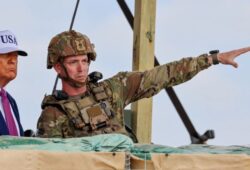
The administration of Donald Trump may have taken a radical turn in its strategy against drug trafficking: according to a report by The New York Times (NYT), the president secretly signed an order authorizing the Pentagon to carry out direct military operations —both at sea and on foreign soil— against drug cartels designated as foreign terrorist organizations. If officially confirmed, this decision would have deep legal, diplomatic, and geopolitical implications, especially for Mexico.
READ ALSO. How did the fentanyl epidemic start? A story of unethical marketing
When asked about this executive order, Mexican President Claudia Sheinbaum stated: “There was some information that an order was coming… It has nothing to do with Mexican territory, it has to do with their country. It has nothing to do with our territory… it’s within the United States, exactly,” she said during her “People’s Morning” press conference.
She added: “Well, we’ll see what the executive order says, but there is no risk of them invading our territory.”
Why does Donald Trump want to use the military against the cartels?
The secret order signed by Trump, reports the NYT, “provides an official basis for the possibility of direct military operations at sea and on foreign soil against the cartels.” This is part of a more aggressive offensive to combat the flow of drugs, especially fentanyl, into the United States.
READ ALSO. Trump’s tariffs drive iPhone panic sales
The NYT notes that White House spokeswoman Anna Kelly explained in an email that “President Trump’s top priority is protecting the homeland, which is why he took the bold step to designate several cartels and gangs as foreign terrorist organizations.”
Which criminal organizations were declared terrorist groups?
Since returning to power in January, Donald Trump has accelerated the designation of criminal groups as terrorist organizations, arguing they represent “a national-security threat beyond that posed by traditional organized crime.”
The Mexican criminal groups classified under this category include:
- Sinaloa Cartel
- Jalisco New Generation Cartel (CJNG)
- United Cartels
- Northeast Cartel
- Gulf Cartel
- New Michoacán Family
In addition, the designation also included the Venezuelan criminal organization Tren de Aragua and Mara Salvatrucha (MS-13), both of which have a presence in the United States and Latin America.
Does the order authorize military attacks on Mexican territory?
While the directive would allow operations outside the United States, the possibility of a unilateral military action in Mexico raises diplomatic tensions and legal concerns. In April, Trump reportedly proposed to President Claudia Sheinbaum allowing military operations on Mexican soil to combat the cartels, but the president rejected the proposal.
What are the precedents for U.S. military use against drug trafficking?
Although this wouldn’t be the first time the United States has involved its armed forces in the fight against drug trafficking in Latin America, this case would mark a turning point:
- In 1989, President George H. W. Bush sent more than 20,000 soldiers to Panama to capture Manuel Noriega. This action was condemned by the UN as a “flagrant violation of international law.”
- During the 1990s, the U.S. supported anti-drug operations in Colombia and Peru through intelligence, but suspended the support after the downing of civilian aircraft.
- The U.S. Navy has participated in maritime interceptions, but always under the command of the Coast Guard.
- Cooperation programs with Mexico and Central America for training and equipment were common but ended in 2017. In Mexico, through the DEA, the U.S. participated in operations to capture leaders of the Sinaloa Cartel, such as Joaquín “El Chapo” Guzmán and Rafael Caro Quintero, both imprisoned in the United States.
In contrast, Trump’s new order appears to favor the direct use of military force to capture or kill suspected drug traffickers, which represents a drastic shift in strategy.
What role do the CIA and other intelligence agencies play in this offensive?
According to the NYT, the U.S. government intensified the use of secret drones over Mexico to locate fentanyl labs. Although the program began during Joe Biden’s administration, Trump escalated it after returning to office, supported by his CIA director, John Ratcliffe.
The CIA is not authorized to use drones for lethal purposes, but it shares intelligence with Mexican authorities. At the same time, the army’s Northern Command has increased aerial surveillance along the border with more than 330 flights, although without entering Mexican airspace.









